La rotta attraverso le Northern Areas è tracciata!The route through the Northern Areas is planned!
 Partenza da Islamabad verso nord per intercettare la leggendaria Karakoram Highway (KKH), il tratto più arduo della Via della Seta che attraverso l’Himalaya conduce fino in Cina (tuttora annoverata tra la 5 strade più pericolose al mondoDeparting from Islamabad direction north to intercept the legendary Karakorum Highway (KKH), the most hard part of the Silk Route that leads to China crossing the Himalayas (still counted as one of the 5 most dangerous roads in the world [link]). Deviazione attraverso la selvaggia Kaghan Valley per infangarci le gomme e visitare le pendici del ghiacciaio. Valico del misterioso Babusar Pass (4173m) e infine nuovamente sulla KKH fino a Gilgit, paese così perso nel mezzo delle montagne himalayane che persino Google Maps non sa se posizionarlo in Pakistan o in India.Diversion trough the wild Kaghan Valley to cover in mud our tires and to visit the slope of the glacier. Mysterious Babusar Pass (4173m) and at last again on the KKH all the way until Gilgit, a village so lost in the Himalayan mountains that even Google Maps doesn’t know if to place it in Pakistan or in India.
Partenza da Islamabad verso nord per intercettare la leggendaria Karakoram Highway (KKH), il tratto più arduo della Via della Seta che attraverso l’Himalaya conduce fino in Cina (tuttora annoverata tra la 5 strade più pericolose al mondoDeparting from Islamabad direction north to intercept the legendary Karakorum Highway (KKH), the most hard part of the Silk Route that leads to China crossing the Himalayas (still counted as one of the 5 most dangerous roads in the world [link]). Deviazione attraverso la selvaggia Kaghan Valley per infangarci le gomme e visitare le pendici del ghiacciaio. Valico del misterioso Babusar Pass (4173m) e infine nuovamente sulla KKH fino a Gilgit, paese così perso nel mezzo delle montagne himalayane che persino Google Maps non sa se posizionarlo in Pakistan o in India.Diversion trough the wild Kaghan Valley to cover in mud our tires and to visit the slope of the glacier. Mysterious Babusar Pass (4173m) and at last again on the KKH all the way until Gilgit, a village so lost in the Himalayan mountains that even Google Maps doesn’t know if to place it in Pakistan or in India.
Ritorno da definire.Return to be defined.
Il primo giorno di viaggio ci riserva poca soddisfazione: è fine giugno, le città sono un forno e le prime colline sono meta del turismo di massa locale. Murree è la prima di queste mete, minuscolo paesino brulicante di turisti con macchina fotografica dove appena scesi veniamo accerchiati. Tempo di permanenza: 15 minuti. Proseguiamo verso nord fino a Nathiagali dove incontriamo le prime scimmie e ci fermiamo per pranzo. Per un pollo allo spiedo vogliono 6€, a Milano lo trovo a meno. Tempo di permanenza: 1 ora.The first day it’s a bit disappointing: it’s the end of June, cities are ovens and the closest hills are the destination for the massive local tourism. Murree is the most know of this destinations, tiny village overloaded of tourist-with-camera, as soon as we go down of the bike we are surrounded. Duration of our stay: 15 minutes. We keep going north until Nathiagali where we meet the first monkeys and where we stop for lunch. For a roasted chicken they want 6€, in Milan I pay it less. Duration of our stay: 1 hour.
Dobbiamo andare più a nord…We must go more north…
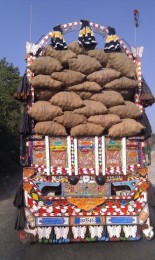 Raggiungiamo l’imbocco della Karakoram Higway, che si rivela davvero pericolosa ma non tanto per le insidie delle montagne quanto per un connubio di smog, camion, traffico, clacson, villaggi intasati, bambini, animali, pessime condizioni stradali e matti alla guida. Per carità, è un quadro molto pittoresco: i camion sono coloratissimi, gli autobus stracarichi di gente fin sul tettoWe reach the access to the Karakoram Highway, which proves to be dangerous for real, not so much for the perils of the mountains, but more for the alliance of smog, trucks, traffic, horns, villages blocked by cars, children, animals, very bad road conditions and crazy drivers. I mean, this is all very picturesque: the trucks are colorful, the buses overloaded with people up to the roof
Raggiungiamo l’imbocco della Karakoram Higway, che si rivela davvero pericolosa ma non tanto per le insidie delle montagne quanto per un connubio di smog, camion, traffico, clacson, villaggi intasati, bambini, animali, pessime condizioni stradali e matti alla guida. Per carità, è un quadro molto pittoresco: i camion sono coloratissimi, gli autobus stracarichi di gente fin sul tettoWe reach the access to the Karakoram Highway, which proves to be dangerous for real, not so much for the perils of the mountains, but more for the alliance of smog, trucks, traffic, horns, villages blocked by cars, children, animals, very bad road conditions and crazy drivers. I mean, this is all very picturesque: the trucks are colorful, the buses overloaded with people up to the roof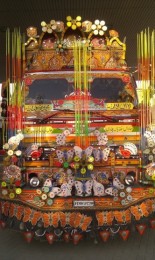 e i villaggi strabordanti di persone, animali e cose, ma in 25km assistiamo a un incidente, rischiamo a nostra volta un frontale e veniamo “spostati” da un enorme pullman. La tecnica di sorpasso micidiale denota totale affidamento al volere di Allah… non è raro vedere macchine che sorpassano altre macchine che sorpassano un camion.
e i villaggi strabordanti di persone, animali e cose, ma in 25km assistiamo a un incidente, rischiamo a nostra volta un frontale e veniamo “spostati” da un enorme pullman. La tecnica di sorpasso micidiale denota totale affidamento al volere di Allah… non è raro vedere macchine che sorpassano altre macchine che sorpassano un camion.
Lasciamo illesi la KKH per entrare nella Kaghan Valley, e’ il tramonto e stremati spegniamo finalmente la moto al PTDC di Balakot (gli alberghi del governo). Il manager ci accoglie benissimo: inizia proponendo la stanza a metà prezzo e concludiamo con la tenda nel giardino gratis… da questo momento in poi, grazie al passaparola, diventeremo ospiti ufficiali (e non paganti) di tutti i PTDC del Pakistan!and the small towns full of people, animals and things, but in less than 25km we witness a car crash, we almost get involved in head-on collision ourselves and we get “moved out of the way” from a huge bus. The deadly overtake technique denotes a complete commitment to Allah’s will… it’s not rare to see cars that overtake other cars that are overtaking a truck.
We leave unharmed the KKH to enter in the Kaghan Valley, it’s sunset and, tired, we finally turn off the motorbike at the Balakot PTDC (the hotels of the government). The manager welcomes us in the best way: he starts by offering us a room for half of the price and ends allowing us to put the tent in the garden for free… from now on, by word of mouth, we become official (and not paying) guests of all the PTDC of all Pakistan!
Ma dov’è questo selvaggio nord che stiamo cercando? E’ forse un’illusione?But where is this wild North that we are looking for? Could it be an illusion?
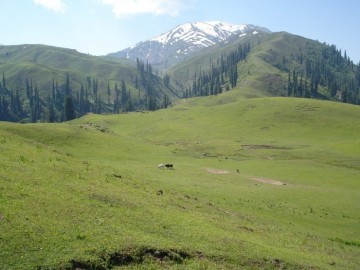 Proseguendo verso nord nella Kaghan Valley deviamo per uno sterrato sassoso che si inerpica fino a 2300m e porta a Shogran. Anche questo villaggio risulta essere estremamente turistico, ma il paesaggio di foreste e praterie verdissime inizia a mostrare i segni della bellezza sorprendente di questa terra. La situazione mette però in risalto tutti i suoi contrasti: villaggi rurali, isolati tutto il resto dell’anno con come unica fonte di sostentamento la pastorizia e il fuoco, si trasformano d’estate in luccicanti fiere del consumismo. Al crepuscolo comincia il concerto dei generatori di elettricità che si accendono uno dopo l’altro coprendo i rumori della notte; l’odore del diesel e le luci delle bancarelle attirano sciami di turisti di città ansiosi di respiare “aria di montagna” e spendere i loro soldi in prodotti “genuini” della loro terra. Come il miele artigianale, versato direttamente da un secchio contenente alcuni pezzi di alveare (sempre gli stessi) completamente immersi in un dolce e denso… zucchero colorato! Oppure i prodotti locali di nonna Nestlè, impacchettati singolarmente con tante piccoleWe keep riding northward in the Kaghan Valley, diverting up on a rocky off-road that climbs up to 2300m to Shogran. Even this village is extremely touristic, but the landscape of forests and bright green meadows starts to show the astonishing beauty of this land. The situation here shows all its contrasts: rural villages, isolated for most of the year with farming and fire as only source of sustenance, during the summer become shiny and consumeristic fairs. At dusk the concert of generators that start one after the other cover the sounds of the night; the smell of diesel and the lights of the stands attract swarms of tourists from the cities eager of breathe “mountain air” and spend their money in “genuine” products of their land. Like homemade honey, poured directly from a bucket, with pieces of comb still inside (always the same ones) completely soaked in a sweet and thick fluid… mostly made of sugar! Or the local products made from grandma Nestlè, packed one by one in many layers
Proseguendo verso nord nella Kaghan Valley deviamo per uno sterrato sassoso che si inerpica fino a 2300m e porta a Shogran. Anche questo villaggio risulta essere estremamente turistico, ma il paesaggio di foreste e praterie verdissime inizia a mostrare i segni della bellezza sorprendente di questa terra. La situazione mette però in risalto tutti i suoi contrasti: villaggi rurali, isolati tutto il resto dell’anno con come unica fonte di sostentamento la pastorizia e il fuoco, si trasformano d’estate in luccicanti fiere del consumismo. Al crepuscolo comincia il concerto dei generatori di elettricità che si accendono uno dopo l’altro coprendo i rumori della notte; l’odore del diesel e le luci delle bancarelle attirano sciami di turisti di città ansiosi di respiare “aria di montagna” e spendere i loro soldi in prodotti “genuini” della loro terra. Come il miele artigianale, versato direttamente da un secchio contenente alcuni pezzi di alveare (sempre gli stessi) completamente immersi in un dolce e denso… zucchero colorato! Oppure i prodotti locali di nonna Nestlè, impacchettati singolarmente con tante piccoleWe keep riding northward in the Kaghan Valley, diverting up on a rocky off-road that climbs up to 2300m to Shogran. Even this village is extremely touristic, but the landscape of forests and bright green meadows starts to show the astonishing beauty of this land. The situation here shows all its contrasts: rural villages, isolated for most of the year with farming and fire as only source of sustenance, during the summer become shiny and consumeristic fairs. At dusk the concert of generators that start one after the other cover the sounds of the night; the smell of diesel and the lights of the stands attract swarms of tourists from the cities eager of breathe “mountain air” and spend their money in “genuine” products of their land. Like homemade honey, poured directly from a bucket, with pieces of comb still inside (always the same ones) completely soaked in a sweet and thick fluid… mostly made of sugar! Or the local products made from grandma Nestlè, packed one by one in many layers 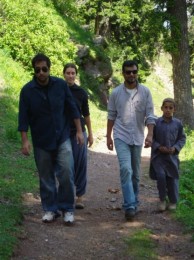 confezioni che doneranno un tocco di colore alla montagna banalmente verde.
confezioni che doneranno un tocco di colore alla montagna banalmente verde.
Inizia anche a delinearsi meglio la figura del Pakistano: i locali sono davvero genuini, ospitali e di mente aperta, si riconoscono dall’abbigliamento tradizionale (la Shalwar Kameez per gli uomini; di donne se ne vedono poche); estremamente maleducati, goffi e infantili i ricchi turisti Punjabi (facilmente riconoscibili dai pantaloncini, la polo, la reflex e il cappello da cow-boy). Queste orde barbariche, principalmente in gruppi di 3 o 4 padri di famiglia, provengono tutte da un unico luogo: Lahore, nel Punjab Pakistano. Ovviamente ci sono eccezioni, come i nostri super-amici di Lahore appena conosciuti: Usman, Rashid e Raaz .
Piantiamo la tenda in un prato, accanto alla baracca del cuoco di un hotel (faremo colazione con lui tutte le mattine), e per qualche giorno alterniamo relax e passeggiate tra i prati fino al ghiacciaio.so that they can give more colors to the ordinarily green mountain.
The figure of the typical Pakistani starts to be outlined: the locals are authentic, welcoming, with an open mind, you can recognize them from the traditional clothes (the Shalwar Kameez for men; women are not very seen); while rude, clumsy and childish are the rich Punjabi tourists (easily recognizable from the shorts, polo shirt, reflex and cow-boy hat). This hordes are mostly in groups of 3 or 4 family men and they all come from the same place: Lahore, in the Pakistani Punjab. Obviously we’ve found some exceptions, like our new, just met, super friends from Lahore: Usman, Rashid and Raaz.
We set our tent in a lawn, next to the hut of a hotel cook (we’ll have breakfast with him every morning), and for a couple of days we alternate between relax and hikes on the meadows up to the glacier.
Al mattino del terzo giorno la strada chiama, salutiamo tutti, finalmente in sella… ma a metà della ripida e fangosa salita per uscire dal paesino una tubatura bagnata affiorante fa perdere completamente aderenza al posteriore; con il gas aperto e la strada una poltiglia non c’è modo di reagire: fulmineo testacoda di 180° strisciando un fianco su fango e sassi. La borsa laterale in (finto) alluminio è letteralmente a brandelli, il portaborse in acciaio è piegato e semi-divelto e il mio ginocchio – sempre quello – mi fa urlare. Terza caduta, tutte a sinistra (come in Turchia), dove legamenti e menischi hanno già dato le dimissioni da un pezzo.
Morale a pezzi, tutto è in discussione; il ginocchio è gonfio, la moto non è in condizioni di viaggio e i giorni rimanenti sul visto sono contati. Tornare a Islamabad? Ma come? Prima di disperare facciamo un tentativo a dir poco ottimista: magari a Balakot (polveroso paesino con un distributore e un ponte) troviamo chi ci raddrizza il telaio portaborse e chi ci costruisce una valigia in metallo su misura con i supporti adatti, il tutto in giornata e per di più di venerdi sabbatico…
Saliamo sui mezzi pubblici per tornare in città con io che zoppico, i resti della borsa tenuti insieme dallo spago e il telaio portaborse tutto piegato. Il disagio iniziale per la nostra condizione miserevole svanisce presto, nel giro di poco sul pulmino sale un tizio con un enorme pezzo di lamiera tutto arrugginito e ci rilassiamo. Eccoci al mercato, tutto è desolatamente chiuso, ma iniziamo a parlare con la gente e attorno a noi si forma un affiatato team di supporto. Nonostante la lingua le cose iniziano a muoversi, passiamo da una bottega semi-aperta ad un’altra, e in men che non si dica, mentre un sordomuto con la fiamma ossidrica ci raddrizza il portaborse direttamente in strada, un vecchietto con la catarattaThe morning of the third day the road is calling us, we say goodbye to everyone, we jump on the bike again… but halfway of the steep and muddy slope to go out of the village a wet water pipe makes us loose grip completely in the rear tire; with the gas open and the road muddy and wet there is no time to react: instantaneous 180° spin scraping the side against rocks and mud. The side pannier made of (fake) aluminum is literally torn to shreds, the pannier holder made of (real) steel is bended and half-wrecked and my knee – always the same one – makes me scream. Third fall, all on the left side (like in Turkey), where ligaments and meniscus already gave up long time ago.
Low in spirits, everything is called into question; the knee is swollen, the bike cannot be ridden without a pannier and the days left on the visa are numbered. Go back to Islamabad? But how? Before giving up in despair we can make another, optimistic, to say the least, attempt: maybe in Balakot (dusty town with one petrol pump and one bridge) we’ll find who can straighten up our pannier holder and who can build a custom-made metal pannier with the right frames, the lot within a day’s time and what’s more, it’s Friday, sabbath-day…
We decide to go back to Balakot with the public transportation: I limp, the rests of the panier are held together with a rope and the frame is completely bended. The initial embarrassment for our miserable condition is going to disappear very soon, when a man with a huge piece of rusty metal sheet gets on the bus and we relax a little bit more.
At the market everything is desolately closed, but we start to talk with the people and a good support team starts to grow around us. Despite the language things start to move, we keep walking from a almost-open shop to another one, and in no time, while a deaf mute with a blowtorch 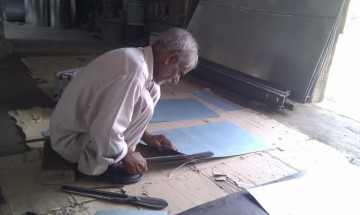 scovato nell’oscurita di una serranda abbassata ci costruisce una valigia in acciaio su misura per meno di 10 €. E’ quasi vittoria, nel frattempo io gironzolo nervoso nella zona ferramenta: devo trovare qualcosa di adatto per i supporti… frugando tra i rottami di un ferrovecchio compero a peso una listella di ferro arrugginito, che con un po’ di fantasia, un gessetto e pochi minuti da un fabbro diventa 2 supporti traforati a “L” che compongono l’ultimo pezzo del nostro puzzle. Missione compiuta, tempo necessario: poche ore.fix our frame in the middle of the street, a old man with the cataract found in the darkness of a half-closed shutter, build us a custom-made steel box for less than 10€. It’s almost done, in the meanwhile I walk around in the hardware stores area, searching in a pile of junk of a scrap dealer I buy a piece of rusty iron, with some imagination, a piece of chalk, and a blacksmith in a flash it becomes 2 L-stands with holes that complete the last piece of our puzzle. Mission complete, time needed: few hours.
scovato nell’oscurita di una serranda abbassata ci costruisce una valigia in acciaio su misura per meno di 10 €. E’ quasi vittoria, nel frattempo io gironzolo nervoso nella zona ferramenta: devo trovare qualcosa di adatto per i supporti… frugando tra i rottami di un ferrovecchio compero a peso una listella di ferro arrugginito, che con un po’ di fantasia, un gessetto e pochi minuti da un fabbro diventa 2 supporti traforati a “L” che compongono l’ultimo pezzo del nostro puzzle. Missione compiuta, tempo necessario: poche ore.fix our frame in the middle of the street, a old man with the cataract found in the darkness of a half-closed shutter, build us a custom-made steel box for less than 10€. It’s almost done, in the meanwhile I walk around in the hardware stores area, searching in a pile of junk of a scrap dealer I buy a piece of rusty iron, with some imagination, a piece of chalk, and a blacksmith in a flash it becomes 2 L-stands with holes that complete the last piece of our puzzle. Mission complete, time needed: few hours.
Questa Caccia al Tesoro al Bazaar di Balakot porta vento d’entusiasmo; lo stesso problema in Europa si sarebbe potuto risolvere o con molti soldi o con molto tempo. Questa vittoria netta verrà ricordata e celebrata per gli anni a venire. Torniamo al PTDC per una lauta cena, meritatamente offertaci, che ci godiamo come nella pubbilcità dell’Amaro Montenegro.This Treasure Hunt at the Balakot Bazar brings new enthusiasm; the same problem in Europe would have been solved either with a lot of money or with a lot of time. This sharp victory will be remembered and celebrated in the years to come. We go back to the PTDC for a lavish deserved dinner, that we enjoy like in the commercial of the Amaro Montenegro… for all the non-Italians who don’t have a culture in italian television or spirits, here is the link to the commercial on youtube. More… Hide…
La Guida, un signore giovane e distinto ma di ceto umile: ci ha visto sul pulmino -ha capito che eravamo pieni di problemi- e si è offerto di farci da guida e traduttore nel bazaar; non che parlasse inglese, ma conosceva i segreti della pazienza.
Il Sordomuto con la Fiamma Ossidrica, che avevamo preso per lo scemo del villaggio quando invece lui aveva già capito tutto mentre gli altri ancora scuotevano la testa; ha dovuto praticamente strapparci di mano il telaio e aggiustarcelo davanti (anche in Iran ci è capitato: coi sordomuti c’è sempre intesa).
Il Vecchietto con la Cataratta, lui varrebbe la pena incontrarlo: vecchio, cieco, rimbambito, con notevoli tremori da Parkinson, senza un tavolo o una luce nel suo laboratorio, solo delle forbici e un martello; ma usa i piedi come fossero mani, e con destrezza, metodo e precisione ha portato a termine il lavoro con sicurezza, senza prendere una misura che fosse una! Nessun robot da catena di montaggio potrebbe vagamente avvicinarsi alla sua efficienza.I want to make a quick sketch of each one of the 3 helpers that we had in this mission, so I will be able to remember them in the future.
The Guide, young man, refined but of humble origins: he saw us on the bus -he guessed we were full of problems- and he offered us to be our guide and translator in the bazaar; not that he could speak english, but he knew the secret of patience.
The Deaf Mute with the BlowTorch, whom we tought was the village idiot whereas he was the only one who understand everything from the beginning while all the others where still shaking their heads; he basically had to wrestle the frame out of our hands and fix it in front of us (even in Iran we had the same experience: with the deaf mute there is understanding)
The Old Man with the Cataract, it would be worth to meet him: old, blind, senile, with evident Parkinson tremors, without a table or a light in his workshop, only a pair of scissors and a hammer; but he uses his feet like hands, and with skills, method and precision he accomplished his job positively, without taking not even one measurament! No assembly line robot could get even close to his efficiency.
Recuperiamo la moto, nel frattempo le nostre conoscenze tra i manager della valle aumentano e siamo graditi ospiti anche a Shogran, dove oramai conosciamo tutti. Veniamo accolti, e in particolare veniamo adottati da una simpatica coppia di Lahore, Ali e sua moglie, che avevano assistito alla caduta ed erano in pensiero per noi.We go back to take our bike, in the meantime our contacts between the manager of the valley grow and we are welcomed guest even in Shogran, where, up to now, we know almost everybody. We are welcomed back and especially we are adopted by a nice couple from Lahore, Ali and his wife, that assisted us at the time of our fall and who where worried for us.
La moto è pronta, ma io? Zoppico e sono intimidito. Non so più se troverò quello che cerco anche proseguendo oltre verso nord… ma se lo trovo, saprò affrontarlo?The bike is ready, but me? I limp and I’m frightened. I’m not sure if I will ever be able to find what I’m looking for even if I continue North… but if I find it, will I be able to face it?
Ma è ora di lasciare il focolare domestico, nella prossima e ultima parte di questa avventura lasceremo finalmente indietro i turisti a gingillarsi con le loro reflex e ci addentreremo nel ghiacciaio, là dove la strada finisce. Tuttavia nuove insidie ci aspettano, e, a Gigit, non ci arriveremo mai…It’s now time to leave hearth and home, in the next and last part of this adventure we’ll finally leave behind the tourists playing with their reflex and we’ll penetrate inside the glacier, there where the road ends. Yet new traps are waiting for us, and, to Gilgit we’ll never reach…
![[:it]Sulla Terra e nel Vento[:en]Overland within the Wind[:]](http://longaterra.net/300kg/wp-content/uploads/sites/15/2016/08/nuovoheaderlogo.jpg)
Raddrizzare un tubo in acciaio, costruire una valigia in alluminio e fare due staffe per fissare il tutto? A Milano ci mettevi due settimane! Fantastico e paradossale che per costruire cose da zero sia molto più facile farlo in uno sperduto paesino del Pakistan che in una metropoli europea. Ma è anche logico in effetti, noi abbiamo tutto pronto ormai, loro spesso devono costruirsi le cose di cui hanno bisogno.
Guarda, ora siamo a Pushkar, e io passo le mattinate ad osservare l’uomo con la fiamma ossidrica (la sua officina è un armadio di metallo sul ciglio della strada).
Che mestiere affascinante… quando avrò una casa io lavorerò il ferro!
Scommettiamo?